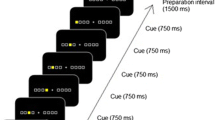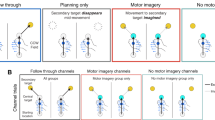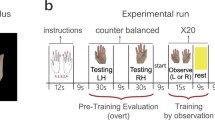Abstract
Motor imagery has been argued to affect the acquisition of motor skills. The present study examined the specificity of motor imagery on the learning of a fine hand motor skill by employing a modified discrete sequence production task: the Go/NoGo DSP task. After an informative cue, a response sequence had either to be executed, imagined, or withheld. To establish learning effects, the experiment was divided into a practice phase and a test phase. In the latter phase, we compared mean response times and accuracy during the execution of unfamiliar sequences, familiar imagined sequences, and familiar executed sequences. The electroencephalogram was measured in the practice phase to compare activity between motor imagery, motor execution, and a control condition in which responses should be withheld. Event-related potentials (ERPs) and event-related lateralizations (ERLs) showed strong similarities above cortical motor areas on trials requiring motor imagery and motor execution, while a major difference was found with trials on which the response sequence should be withheld. Behavioral results from the test phase showed that response times and accuracy improved after physical and mental practice relative to unfamiliar sequences (so-called sequence-specific learning effects), although the effect of motor learning by motor imagery was smaller than the effect of physical practice. These findings confirm that motor imagery also resembles motor execution in the case of a fine hand motor skill.









Similar content being viewed by others
References
Abrahamse EL, Verwey WB (2008) Context dependent learning in the serial RT task. Psychol Res 72:397–404
Abrahamse EL, Ruitenberg MF, de Kleine E, Verwey WB (2013) Control of automated behavior: insights from the discrete sequence production task. Front Hum Neurosci 7:1–16
Allami N, Paulignan Y, Brovelli A, Boussaoud D (2008) Visuo-motor learning with combination of different rates of motor imagery and physical practice. Exp Brain Res 184:105–113
Allami N, Brovelli A, Hamzaoui EM, Regragui F, Paulignan Y, Boussaoud D (2014) Neurophysiological correlates of visuo-motor learning through mental and physical practice. Neuropsychologia 55:6–14
Annett M (1970) A classification of hand preference by association analysis. Br J Psychol 61:303–321
Batson G, Feltman R, Waring J (2007) Effect of mental practice combined with physical practice on balance in the community-dwelling elderly. Act Adapt Aging 31:1–18
Caldara R, Deiber M-P, Andrey C, Michel CM, Thut G, Hauert C-A (2004) Actual and mental motor preparation and execution: a spatiotemporal ERP study. Exp Brain Res 159:389–399
Carillo-de-la-Peña MT, Galdo-Álvarez S, Lastra-Barreira C (2008) Equivalent is not equal: primary motor cortex (MI) activation during motor imagery and execution of sequential movements. Brain Res 1226:134–143
Cho H, Kim J, Lee G (2013) Effects of motor imagery training on balance and gait abilities in post-stroke patients: a randomized controlled trial. Clin Rehabil 27:675–680
Coelho CJ, Rosenbaum DA, Nusbaum HC, Fenn KM (2012) Imagined actions aren`t just weak actions: task variability promotes skill learning in physical practice but not in mental practice. J Exp Psychol 38:1759–1764
Čoh M, Jovanović-Golubović D, Bratić M (2004) Motor learning in sport. Phys Educ Sport 2:45–59
Cumming J, Hall C, Shambrook C (2004) The influence of an imagery workshop on athletes’ use of imagery. Online J Sport Psychol 6:52–73
De Jong R, Wierda M, Mulder L (1988) Use of partial information in responding. J Exp Psychol Hum Percept Perform 14:682–692
De Kleine E, Van der Lubbe RH (2011) Decreased load on general motor preparation and visual-working memory while preparing familiar as compared to unfamiliar movement sequences. Brain Cognit 75:126–134
Debarnot U, Clerget E, Olivier E (2011) The role of the primary motor cortex in the early boost in performance following mental imagery training. PLoS One 6:1–9
Debarnot U, Abichou K, Kalenzaga S, Sperduti M, Piolino P (2015) Variable motor imagery training induces sleep memory consolidation and transfer improvements. Neurobiol Learn Mem 119:85–92
Diedrichsen J, Kornysheva K (2015) Motor skill learning between selection and execution. Trends Cognit Sci 19:227–233
Dijkerman HI, Johnston M, MacWalter R (2004a) Does motor imagery training improve hand function in chronic stroke patients? A pilot study. Clin Rehabil 18:538–549
Dijkerman H, Ietswaart M, Johnston M, MacWalter R (2004b) Does motor imagery training improve hand function in chronic stroke patients? A pilot study. Clin Rehabil 18:538–549
Doussoulin A, Rehbein L (2011) Motor imagery as a tool for motor skill training in children. Motricidade 7:37–43
Fansler CL, Poff CL, Shepard KF (1985) Effects of mental practice on balance in elderly women. Phys Ther 65:1332–1338
Galdo-Álvarez S, Carrillo-de-la-Peña MT (2004) ERP evidence of MI activation without motor response execution. Mot Syst 15:2067–2070
Gentili R, Papaxanthis C (2015) Laterality effects in motor learning by mental practice in right-handers. Neuroscience 297:231–242
Gentili R, Han CE, Schweighofer N, Papaxanthis C (2010) Motor learning without doing: trial-by-trial improvement in motor performance during mental training. J Neurophysiol 104:774–783
Gratton G, Coles MG, Sirevaag EJ, Eriksen CW, Donchin E (1988) Pre- and post-stimulus activation of response channels: a psychophysiological analysis. J Exp Psychol Hum Percept Perform 14:331–344
Guillot A, Collet C (2005) Contribution from neurophysiological and psychological methods to the study of motor imagery. Brain Res Rev 50:387–397
Hird JS, Landers DM, Thomas JR, Horan JJ (1991) Physical practice is superior to mental practice in enhancing cognitive and motor task performance. J Sport Exerc Psychol 8:281–293
Jeannerod M (2001) Neural simulation of action: a unifying mechanism for motor cognition. Neuroimage 14:103–109
Jongsma ML, Meulenbroek RG, Okely J, Baas C, van der Lubbe RH, Steenbergen B (2013) Effects of hand orientation on motor imagery—event related potentials suggest kinesthetic motor imagery to solve the hand laterality judgment task. PLoS One 8:1–10
Kosslyn SM, Ganis G, Thompson WL (2001) Neural foundations of imagery. Nat Rev 2:635–642
Kraeutner S, Gionfriddo A, Bardouille T, Boe S (2014) Motor imagery-based brain activity parallels that of motor execution: evidence from magnetic source imaging of cortical oscillations. Brain Res 1588:81–91
Kranczioch C, Mathews S, Dean PJ, Sterr A (2009) On the equivalence of executed and imagined movements: evidence from lateralized motor and nonmotor potentials. Hum Brain Mapp 30:3275–3286
Kranczioch C, Mathews S, Dean P, Sterr A (2010) Task complexity differentially affects executed and imagined movement preparation: evidence from movement-related potentials. PLoS ONE 5:1–9
Lebon F, Collet C, Guillot A (2010) Benefits of motor imagery training on muscle strength. J Strength Cond Res 24:1680–1687
Lee G, Song C, Lee Y, Cho H, Lee S (2011) Effects of motor imagery training on gait ability of patiens with chronic stroke. J Phys Ther Sci 23:197–200
Luft AR, Buitrago MM (2005) Stages of motor skill learning. Mol Neurobiol 32:205–216
Machado S, Arias-Carrión O, Paes F, Ribeiro P, Cagy M, Piedade R, Nardi E (2013) Changes in cortical activity during real and imagined movements: an ERP study. Clin Pract Epidemiol Ment Health 9:196–201
Maillet A, Fraix V, Thobois S, Derost P, Bloem B, Pollak P, Debû B (2013) Kinesthetic imagery of gait in advanced Parkinson’s disease. EDP Sci 82:115–128
Miller KJ, Schalk G, Fetz EE, Ojemann JG, Rao RP (2010) Cortical activity during motor execution, motor imagery, and imagery-based online feedback. PNAS Early Ed pp 1–6
Mizuguchi N, Nakata H, Uchida Y, Kanosue K (2012) Motor imagery and sport performance. J Sports Med Phys Fit 1:103–111
Mulder T, Zijlstra S, Zijlstra W (2004) The role of motor imagery in learning a totally novel movement. Exp Brain Res 154:211–217
Munzert J, Lorey B, Zentgraf K (2009) Cognitive motor processes: the role of motor imagery in the study of motor representations. Brain Res Rev 60:306–326
Oostenveld R, Praamstra P (2001) The five percent electrode system for high-resolution EEG and ERP measurements. Clin Neurophysiol 112:713–719
Pascual-Leone A, Nguyet D, Cohen LG, Brasil-Neto JP, Cammarota A, Hallett M (1995) Modulation of muscle responses evoked by transcranial magnetic stimulation during the acquisition of new fine motor skills. J Neurophysiol 74:1037–1045
Payne VG, Isaacs DL (1987) Human motor development: a lifespan approach. Mayfield Publishing Company, Mountain View California
Ranganathan VK, Siemionow V, Liu JZ, Sahgal V, Yue GH (2004) From mental power to muscle power—gaining strength by using the mind. Neuropsychologia 42:944–956
Ruitenberg MF, De Kleine E, Van der Lubbe RH, Verwey WB, Abrahamse EL (2011) Context-dependent motor skill and the role of practice. Psychol Res 76:812–820
Schuster C, Hilfiker R, Amft O, Anne S, Andrews B, Butler J, Ettlin T (2011) Best practice for motor imagery: a systematic literature review on motor imagery training elements in five different disciplines. BMC Med 9:1–35
Schuster C, Butler J, Andrews B, Kischka U, Ettlin T (2012) Comparison of embedded and added motor imagery training in patients after stroke: results of a randomised controlled pilot trial. Trials 13:1–19
Sirigu A, Duhamel J (2001) Motor and visual imagery as two complementary but neurally dissociable mental processes. J Cognit Neurosci 13:910–919
Solodkin A, Hlustik P, Chen EE, Small SL (2004) Fine modulation in network activation during motor execution and motor imagery. Cereb Cortex 14:1246–1255
Stecklow MV, Infantosi AF, Cagy M (2010) EEG changes during sequences of visual and kinesthetic motor imagery. Arq Neuropsiquiatr 68:556–561
Talsma D, Wijers AA, Klaver P, Mulder G (2001) Working memory processes show different degrees of lateralization: evidence from event-related potentials. Psychophysiology 38:425–439
Tangwiriyasakul C, Mocioiu V, van Putten M, Rutten WL (2014) Classification of motor imagery performance in acute stroke. J Neural Eng 11:1–9
Van der Lubbe RH, Wauschkuhn B, Wascher E, Niehoff T, Kömpf D (2000) Lateralized EEG components with direction information for the preparation of saccades versus finger movements. Exp Brain Res 132:163–178
Van der Lubbe RH, Bundt C, Abrahamse EL (2014) Internal and external spatial attention examined with lateralized EEG power spectra. Brain Res 1583:179–192
Verwey WB (2015) Contributions from associative and explicit sequence knowledge to the execution of discrete keying sequences. Acta Psychologica 157:122–130
Wascher E, Wauschkuhn B (1996) The interaction of stimulus- and response-related processes measured by event-related lateralizations of the EEG. Electroencephalogr Clin Neurophysiol 99:149–162
Willingham DB (1998) A neuropsychological theory of motor skill learning. Psychol Rev 105:558–584
Wulf G, Shea C, Lewthwaite R (2010) Motor skill learning and performance: a review of influential factors. Med Educ 44:75–84
Xu L, Zhang H, Hui M, Long Z, Jin Z, Liu Y, Yao L (2014) Motor execution and motor imagery: a comparison of functional connectivity patterns basen on graph theory. Neuroscience 261:184–194
Yue G, Cole KJ (1992) Strength increases from the motor program: comparison of training with maximal voluntary and imagined muscle contractions. J Neurophysiol 67:1114–1123
Acknowledgments
This work was supported by a grant from the National Science Centre in Poland, UMO-2012/05/B/HS6/03806. Rob van der Lubbe and Willem Verwey were supported by the Institute for Biomedical Technology and Technical Medicine (MIRA). All authors disclose any sources of conflict of interest. We thank Edyta Przybyłowska for her help in running the experiment. The authors want to thank all the participants who participated in this study.
Author information
Authors and Affiliations
Corresponding author
Ethics declarations
Conflict of interest
The authors confirm that this article content has no conflicts of interest.
Appendix
Appendix

Rights and permissions
About this article
Cite this article
Sobierajewicz, J., Przekoracka-Krawczyk, A., Jaśkowski, W. et al. The influence of motor imagery on the learning of a fine hand motor skill. Exp Brain Res 235, 305–320 (2017). https://doi.org/10.1007/s00221-016-4794-2
Received:
Accepted:
Published:
Issue Date:
DOI: https://doi.org/10.1007/s00221-016-4794-2




